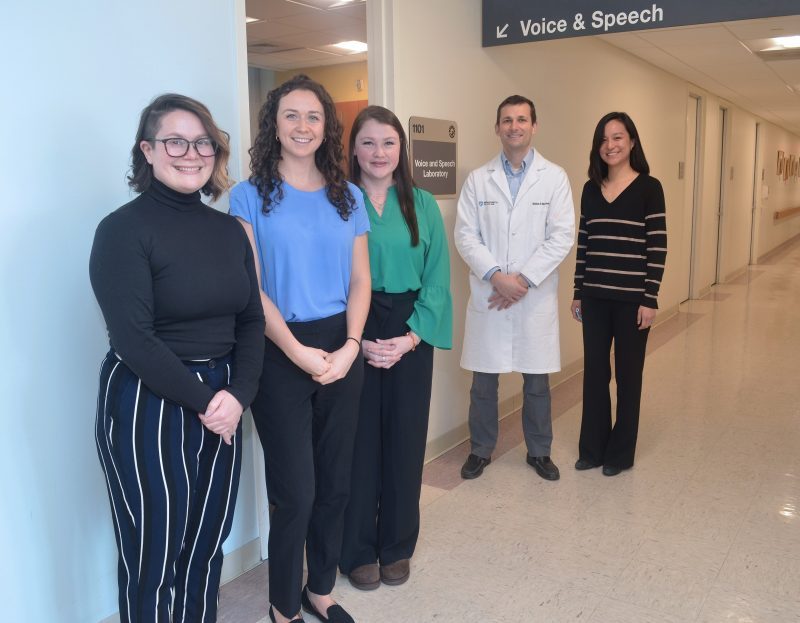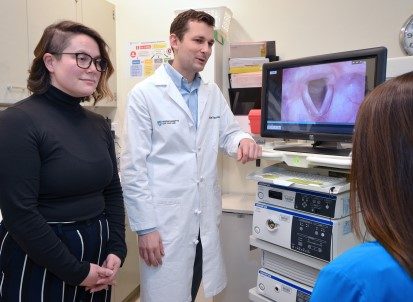For years, insurance providers have hesitated to consider voice and speech modification a medical necessity for transgender individuals. Through its Transgender Voice and Speech Modification Program, physicians at Mass Eye and Ear have begun blazing a trail to change that narrative.
For members of the transgender community, there has never been a more dangerous time to live in the United States. Human Rights Watch, an international non-government organization, reported 2021 as the nation’s deadliest year for anti-transgender violence. A recent rise in verbal and physical attacks has paralyzed the community into a constant state of fear.
Transgender individuals often do their best to change their secondary sex characteristics, which include residual facial hair, voice tones and posture. When any one of these characteristics misaligns with their identified gender in public, the individual feels “outed,” which poses a significant risk for self-harm.
Gender dysphoria, the psychological distress from a person’s identified gender not matching their appearance, is associated with an increased risk of depression and suicide. According to results of a 2015 survey produced by the National Center for Transgender Equality, more than 40 percent of transgender respondents had attempted suicide at one point in their life—nearly nine times higher than the attempted suicide rate of the U.S. population.
The recent harm inflicted upon transgender individuals has raised an alarm within the medical community. Those who once doubted the medical necessity of correcting secondary sex characteristics are now beginning to reevaluate their thinking.
“Years ago, you could imagine a scenario where a woman might come to her doctor and say, ‘My voice is too low and doesn’t seem right,’ only for the doctor to inform her that nothing can be done,” said Matthew R. Naunheim, MD, MBA, an ENT surgeon in the Division of Laryngology at Mass Eye and Ear. “We now know how risky it is for a transgender individual to be ‘outed’ because their voice sounds too much like that of a man or woman.”
In support of this paradigm shift, Dr. Naunheim has collaborated alongside several speech-language pathologists to launch the Transgender Voice and Speech Modification Program at Mass Eye and Ear.
The program began in 2019 and has since offered gender-affirming voice care to individuals across Greater Boston looking for a voice they feel safe projecting to the world. Thanks to its multidisciplinary approach, the program has already treated over 100 patients and is now preparing to combat a larger problem looming on the horizon: Convincing insurance providers to consider gender-affirming care a necessity.

Members of the Transgender Voice and Speech Modification Program pictured from left to right: Stefani Kalos, MS, CCC-SLP; Abigail Garneau, MA, CCC-SLP; Kara Aries; Matthew R. Naunheim, MD, MBA; Carolyn Hsu, MS, CCC-SLP.
More than pitch
A natural association exists between gender and a person’s voice. Men typically have lower voices, and women typically have higher voices. Physicians refer to how high or low the voice goes as pitch. Different levels of pitch can depend on the anatomic structure of the vocal cord muscles. Shorter muscles tend to produce higher pitches, whereas longer muscles tend to produce lower pitches.
“Think of it like tuning a guitar,” Dr. Naunheim said. “Shorter strings generate higher sounds. On the other hand, a longer string generates a low sound.”
While patients can use testosterone to thicken the vocal cords for a deeper-sounding voice, no hormonal therapy exists for heightening the voice. An anatomical change to heighten the voice would require a gender-affirming procedure called a glottoplasty. During this procedure, a laryngologist de-epithelializes parts of both vocal cords and creates a web to shorten the cords with sutures. Since a limit exists to how short surgeons can make the vocal cord, only so much of a person’s pitch can change from such a procedure. This might discourage patients who assume no other options exist to further modify their voice.
However, pitch is just one of several different variables capable of changing how a voice sounds. According to Stefani Kalos, MS, CCC-SLP, a speech-language pathologist at Mass Eye and Ear, a person can modify certain variables such as resonance, inflection and articulation to compensate for pitches that sound too high or too low.
“Voices are a lot more flexible than people imagine, and pitch is only a small portion of how a voice can be perceived,” said Stefani. “By working with a speech therapist who can explain how these variables are manipulated using scientifically-backed voice techniques, we can try on different techniques until we have tailored a voice that best fits a person’s gender and personality.”
A voice that fits just right

Modification Program. Photo taken prior to COVID-19.
After years of feeling underserved or marginalized by the medical community, transgender individuals may feel uncomfortable seeing a licensed professional to alter their voice. They instead might try altering their voice on their own.
According to Abigail Garneau, MA, CCC-SLP, a speech-language pathologist at Mass Eye and Ear, individuals who attempt voice-altering techniques without the discretion of a professional can risk harming their voice. Individuals who turn to certain online instructional videos without fully understanding how to apply a specific voice technique, for example, may risk laryngeal hyperfunction, or a strained larynx.
If such a condition occurs, a speech-language pathologist can help undo the strain and guide a patient to their target voice.
“If a patient explores modifying their voice on their own, we encourage them to practice vigilance for issues like hoarseness, strain or pain in the throat,” she said. “If any of these issues are noted, we then recommend seeking out a medical professional, if possible. The last thing we’d want is for an individual to hurt their voice or throat.”
The Transgender Voice and Speech Modification Program attempts to build strong, trusting relationships between patients and clinicians by employing a shared-decision approach to care. The approach begins with Dr. Naunheim and a speech-language pathologist conducting a thorough evaluation of the patient’s medical history. Several recordings are made of the patient’s voice, after which point Dr. Naunheim can order a laryngoscopy exam to assess the larynx for vocal fold nodules, polyps or any other pre-existing pathologies. The speech-language pathologist can also assign a few initial voice exercises and test how the patient responds.
Once the team completes its workup, Dr. Naunheim and a speech-language pathologist meet with the patient to present a complete array of treatment options. Voice therapy sessions, each one 45-to-50 minutes long, are typically recommended first. The number of sessions and techniques taught can be adjusted to the needs of each individual. Permanent treatment options, such as surgical procedures or hormonal therapy, are usually recommended second. Those who choose a permanent treatment option can still modify and adjust their voice with voice therapy sessions, but they must receive the approval of a surgeon weeks after their procedure.
Access for everyone
Every year since the Transgender Voice and Speech Modification Program began its operations, patient volume has more than doubled. Its immediate success culminated in a 2021 Pillars of Excellence Award from Mass General Brigham, which recognized the program’s promotion of diversity, equity and inclusion across the healthcare system.
Despite the program’s immediate success, Dr. Naunheim knows that gender-affirming care is still inaccessible to hundreds of thousands of individuals nationwide. He noted that a majority of insurance providers do not cover procedures for correcting secondary sex characteristics. These providers only cover procedures that correct primary sex characteristics, such as genital reconstructive surgery.
Providers will often cite published outcomes to justify covering a procedure they deem a medical necessity. With few published outcomes available for transgender voice modification procedures, Dr. Naunheim has begun collecting his own patient-reported outcome data. This data includes patient satisfaction scores from before and after voice therapy sessions, changes in the frequency of a patient’s voice and qualitative interviews with patients experiencing gender dysphoria. He believes his research could one day promote equity for a community that continues to move further and further to society’s margins.
“Every person should feel comfortable in the way their voice is presented to the world,” Dr. Naunheim said. “If we have the means available to ensure peace of mind among transgender individuals, then we must ensure these techniques are available to all, and not just a fortunate few.”
Reprinted with permission from Harvard Otolaryngology Magazine.

This is wonderful news! But please also do your utmost to allocate more funding, and staff to fast tracking a genetic and/or stem cell based cure for the most common forms of hearing loss. https://www.masseyeandear.org/news/press-releases/2019/12/reprogramming-the-inner-ear-to-regrow-hair-cells-shows-promise-to-be-an-effective-target-for-hearing-loss-treatments
Thank you.